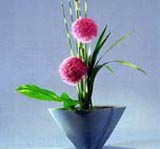 In spring, flowers in full bloom cover hills, mountains and gardens throughout China.
In spring, flowers in full bloom cover hills, mountains and gardens throughout China.
Festivals are held in various regions to celebrate their beauty.
For those who find it difficult to take time off to go outings, you can arrange a bouquet at home to decorate your home as well as enjoy its fragrance.
"The number of flower-arranging amateurs totals several hundreds of thousands in Shanghai," said Cai Zhongjuan, president of the Shanghai Flower Art and Arrangement Association.
Cai added that there are about 3,000 persons in the city attending the association, who can teach flower arrangement on a professional level.
Flowers have special meaning to Cai, who has been in the flower-arrangement business since she graduated from college in 1959.
Cai majored in gardening, and her first job was arranging flowers for receptions of state guests.
However, as the "cultural revolution"(1966-76) began, she quit her job. Though she was forced to pursue a different profession during that period, she did not give up her pursuit for the art.
Whenever she saw TV broadcasts of Chinese officials visiting other countries, she would pay close attention to the reception settings, especially the flower arrangements.
The 1980s blew seeds of change throughout China with the new opening-up policies, an historic moment that nurtured both international ties and artistic freedoms at home.
Cai recalls the Second International Flower Exhibition held in Yugoslavia, the first that China competed in.
Cai said it saddened her to see how little international recognition in the flower-arrangement world the Chinese received at that time. This experience propelled her to ensure China's development of the craft.
It was more of a rediscovery of an ancient Chinese art, Cai said, noting that flower arranging dates back to the Southern and Northern Dynasties (420-581) and enjoyed rapid growth in the Tang (618-907) and Song (960-1279) dynasties.
During the Tang Dynasty, the art was introduced to Japan by Ono no Imoko, a Japanese monk, said Rachel Xie, general manager of Everlasting Wedding Specials.
In China, Ono no Imoko had studied flower arrangings as religious offerings. From this he developed Ikenobo, the Japan's oldest school of Ikebana, literally translated as "The Way of the Flower".
"We achieved great success in the exhibition in Yugoslavia, and won the top awards. Then I decided I should work hard to let more people know the art and let the world know about the Chinese way of arranging flowers," Cai said.
After Cai returned home, she started compiling her own teaching materials because there were any books about the art.
"Flower arranging is regarded as an aristocratic art in Hong Kong and Taiwan. Someone told me one lesson lasting two hours will cost about US$65. It is not thought of in this way in China and we are determined to teach more people in order to improve the art," she said.
Cai put her idea into practice. For elementary level courses, she only charged the students 390 yuan (US$47), and the tuition includes the expense of flowers and foliage. For intermediate and advanced courses, the tuitions are 490 yuan (US$59) and 590 yuan (US$71), respectively. Every year, Shanghai Flower Art School produces about 2,000 amateurs and 100 professionals.
Currently one-third of the students are or will be in the flower arranging business, but the rest of the students learn the art merely out of a love for flowers.
One professor who has just retired is a student in the intermediate class.
"The professor used to teach literature, so her designs are full of meanings embodied in poems of the Tang Dynasty," Cai said.
"Shanghai Flower Art School not only invites top-level teachers to give lessons to us, but also invites flower arranging artists all over the world to give lectures. This enables me to learn more than I do in university," said one student surnamed Wang, who is also studying gardening art at university.
Recently, a Japanese artist was invited to lecture at the school. The artist, named Gyokurei Yamamoto, is the head of Ikenobo Seiryu School in Osaka. He is honorary consultant of the Shanghai Flower Art and Arrangement Association and also a good friend of Cai's.
"Every year, I come to Shanghai three or four times and spend 500,000 yen ($4,098) to come to Shanghai to teach students here," Gyokurei Yamamoto said. "Though the expense is large and would have built me a house in Japan, I love to come here and exchange my skills with people in China."
Shanghai Municipality has granted Gyokurei Yamamoto the Magnolia Award for his passion for teaching. However, the students' zest for learning is also a big reward, according to Yamamoto.
"I love art very much. Though next month I will go abroad with my parents, I will not miss a lesson from now on," said Jane Cheng, a university student.
Cheng said her foreign friends also like flower arranging very much. "Maybe when I arrive in San Francisco, I will try my best to set up a florist shop," Cheng said, smiling.
(Shanghai Star 04/26/2001)
